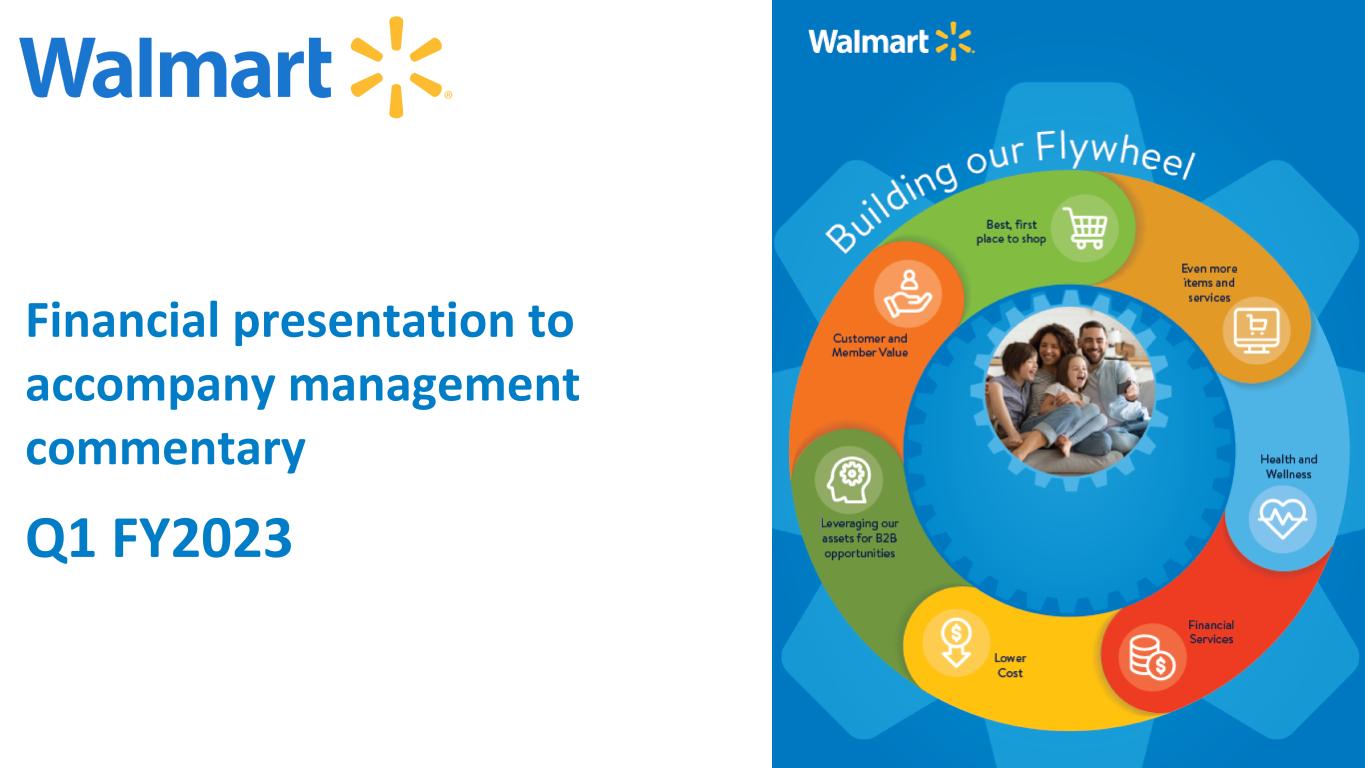
Q1 FY2023 Financial presentation to accompany management commentary
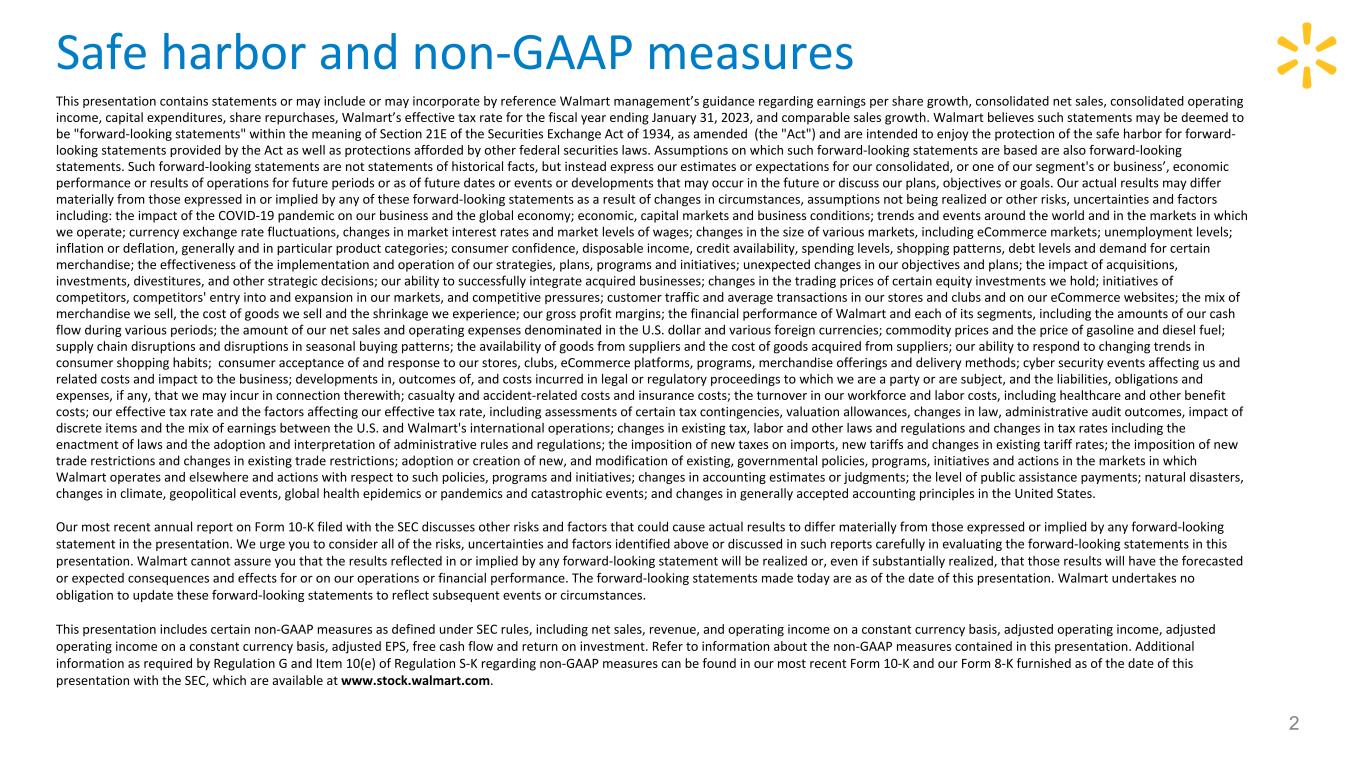
This presentation contains statements or may include or may incorporate by reference Walmart management’s guidance regarding earnings per share growth, consolidated net sales, consolidated operating income, capital expenditures, share repurchases, Walmart’s effective tax rate for the fiscal year ending January 31, 2023, and comparable sales growth. Walmart believes such statements may be deemed to be "forward-looking statements" within the meaning of Section 21E of the Securities Exchange Act of 1934, as amended (the "Act") and are intended to enjoy the protection of the safe harbor for forward- looking statements provided by the Act as well as protections afforded by other federal securities laws. Assumptions on which such forward-looking statements are based are also forward-looking statements. Such forward-looking statements are not statements of historical facts, but instead express our estimates or expectations for our consolidated, or one of our segment's or business’, economic performance or results of operations for future periods or as of future dates or events or developments that may occur in the future or discuss our plans, objectives or goals. Our actual results may differ materially from those expressed in or implied by any of these forward-looking statements as a result of changes in circumstances, assumptions not being realized or other risks, uncertainties and factors including: the impact of the COVID-19 pandemic on our business and the global economy; economic, capital markets and business conditions; trends and events around the world and in the markets in which we operate; currency exchange rate fluctuations, changes in market interest rates and market levels of wages; changes in the size of various markets, including eCommerce markets; unemployment levels; inflation or deflation, generally and in particular product categories; consumer confidence, disposable income, credit availability, spending levels, shopping patterns, debt levels and demand for certain merchandise; the effectiveness of the implementation and operation of our strategies, plans, programs and initiatives; unexpected changes in our objectives and plans; the impact of acquisitions, investments, divestitures, and other strategic decisions; our ability to successfully integrate acquired businesses; changes in the trading prices of certain equity investments we hold; initiatives of competitors, competitors' entry into and expansion in our markets, and competitive pressures; customer traffic and average transactions in our stores and clubs and on our eCommerce websites; the mix of merchandise we sell, the cost of goods we sell and the shrinkage we experience; our gross profit margins; the financial performance of Walmart and each of its segments, including the amounts of our cash flow during various periods; the amount of our net sales and operating expenses denominated in the U.S. dollar and various foreign currencies; commodity prices and the price of gasoline and diesel fuel; supply chain disruptions and disruptions in seasonal buying patterns; the availability of goods from suppliers and the cost of goods acquired from suppliers; our ability to respond to changing trends in consumer shopping habits; consumer acceptance of and response to our stores, clubs, eCommerce platforms, programs, merchandise offerings and delivery methods; cyber security events affecting us and related costs and impact to the business; developments in, outcomes of, and costs incurred in legal or regulatory proceedings to which we are a party or are subject, and the liabilities, obligations and expenses, if any, that we may incur in connection therewith; casualty and accident-related costs and insurance costs; the turnover in our workforce and labor costs, including healthcare and other benefit costs; our effective tax rate and the factors affecting our effective tax rate, including assessments of certain tax contingencies, valuation allowances, changes in law, administrative audit outcomes, impact of discrete items and the mix of earnings between the U.S. and Walmart's international operations; changes in existing tax, labor and other laws and regulations and changes in tax rates including the enactment of laws and the adoption and interpretation of administrative rules and regulations; the imposition of new taxes on imports, new tariffs and changes in existing tariff rates; the imposition of new trade restrictions and changes in existing trade restrictions; adoption or creation of new, and modification of existing, governmental policies, programs, initiatives and actions in the markets in which Walmart operates and elsewhere and actions with respect to such policies, programs and initiatives; changes in accounting estimates or judgments; the level of public assistance payments; natural disasters, changes in climate, geopolitical events, global health epidemics or pandemics and catastrophic events; and changes in generally accepted accounting principles in the United States. Our most recent annual report on Form 10-K filed with the SEC discusses other risks and factors that could cause actual results to differ materially from those expressed or implied by any forward-looking statement in the presentation. We urge you to consider all of the risks, uncertainties and factors identified above or discussed in such reports carefully in evaluating the forward-looking statements in this presentation. Walmart cannot assure you that the results reflected in or implied by any forward-looking statement will be realized or, even if substantially realized, that those results will have the forecasted or expected consequences and effects for or on our operations or financial performance. The forward-looking statements made today are as of the date of this presentation. Walmart undertakes no obligation to update these forward-looking statements to reflect subsequent events or circumstances. This presentation includes certain non-GAAP measures as defined under SEC rules, including net sales, revenue, and operating income on a constant currency basis, adjusted operating income, adjusted operating income on a constant currency basis, adjusted EPS, free cash flow and return on investment. Refer to information about the non-GAAP measures contained in this presentation. Additional information as required by Regulation G and Item 10(e) of Regulation S-K regarding non-GAAP measures can be found in our most recent Form 10-K and our Form 8-K furnished as of the date of this presentation with the SEC, which are available at www.stock.walmart.com. 2 Safe harbor and non-GAAP measures
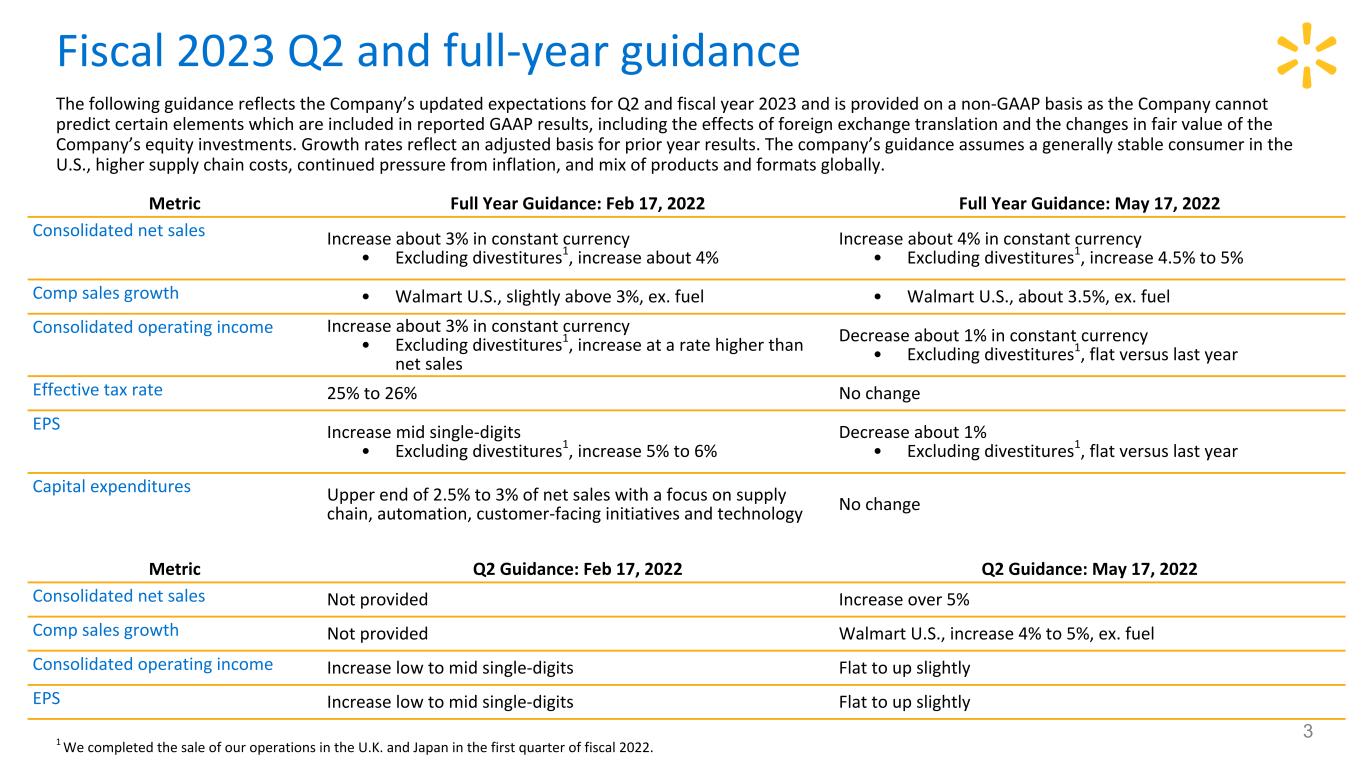
3 Fiscal 2023 Q2 and full-year guidance The following guidance reflects the Company’s updated expectations for Q2 and fiscal year 2023 and is provided on a non-GAAP basis as the Company cannot predict certain elements which are included in reported GAAP results, including the effects of foreign exchange translation and the changes in fair value of the Company’s equity investments. Growth rates reflect an adjusted basis for prior year results. The company’s guidance assumes a generally stable consumer in the U.S., higher supply chain costs, continued pressure from inflation, and mix of products and formats globally. 1 We completed the sale of our operations in the U.K. and Japan in the first quarter of fiscal 2022. Metric Full Year Guidance: Feb 17, 2022 Full Year Guidance: May 17, 2022 Consolidated net sales Increase about 3% in constant currency • Excluding divestitures1, increase about 4% Increase about 4% in constant currency • Excluding divestitures1, increase 4.5% to 5% Comp sales growth • Walmart U.S., slightly above 3%, ex. fuel • Walmart U.S., about 3.5%, ex. fuel Consolidated operating income Increase about 3% in constant currency • Excluding divestitures1, increase at a rate higher than net sales Decrease about 1% in constant currency • Excluding divestitures1, flat versus last year Effective tax rate 25% to 26% No change EPS Increase mid single-digits • Excluding divestitures1, increase 5% to 6% Decrease about 1% • Excluding divestitures1, flat versus last year Capital expenditures Upper end of 2.5% to 3% of net sales with a focus on supply chain, automation, customer-facing initiatives and technology No change Metric Q2 Guidance: Feb 17, 2022 Q2 Guidance: May 17, 2022 Consolidated net sales Not provided Increase over 5% Comp sales growth Not provided Walmart U.S., increase 4% to 5%, ex. fuel Consolidated operating income Increase low to mid single-digits Flat to up slightly EPS Increase low to mid single-digits Flat to up slightly
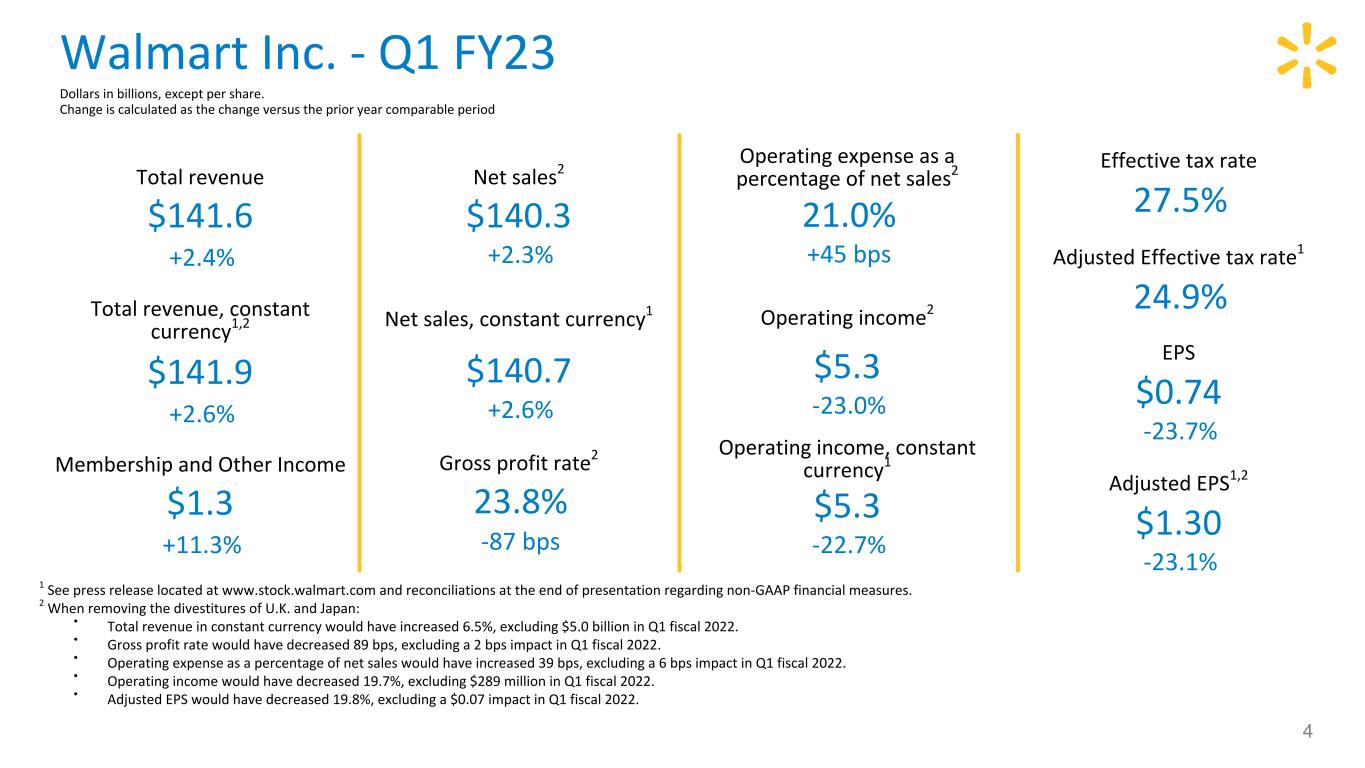
4 Total revenue $141.6 +2.4% Total revenue, constant currency1,2 $141.9 +2.6% Membership and Other Income $1.3 +11.3% Net sales2 $140.3 +2.3% Net sales, constant currency1 $140.7 +2.6% Gross profit rate2 23.8% -87 bps Operating expense as a percentage of net sales2 21.0% +45 bps Operating income2 $5.3 -23.0% Operating income, constant currency1 $5.3 -22.7% Effective tax rate 27.5% Adjusted Effective tax rate1 24.9% EPS $0.74 -23.7% Adjusted EPS1,2 $1.30 -23.1% Walmart Inc. - Q1 FY23 Dollars in billions, except per share. Change is calculated as the change versus the prior year comparable period 1 See press release located at www.stock.walmart.com and reconciliations at the end of presentation regarding non-GAAP financial measures. 2 When removing the divestitures of U.K. and Japan: • Total revenue in constant currency would have increased 6.5%, excluding $5.0 billion in Q1 fiscal 2022. • Gross profit rate would have decreased 89 bps, excluding a 2 bps impact in Q1 fiscal 2022. • Operating expense as a percentage of net sales would have increased 39 bps, excluding a 6 bps impact in Q1 fiscal 2022. • Operating income would have decreased 19.7%, excluding $289 million in Q1 fiscal 2022. • Adjusted EPS would have decreased 19.8%, excluding a $0.07 impact in Q1 fiscal 2022. Adj. operating income, constant currency1,2 $5.4 -23.1%

1 Debt to total capitalization calculated as of April 30, 2022. Debt includes short-term borrowings, long-term debt due within one year, finance lease obligations due within one year, long- term debt and long-term finance lease obligations. Total capitalization includes debt and total Walmart shareholders' equity. 2 Calculated for the trailing 12 months ended April 30, 2022. For ROI, see reconciliations at the end of presentation regarding non-GAAP financial measures. 5 Receivables, net Debt to capitalization1 $7.7 40.4% +32.4% +220 bps Inventories Return on assets2 $61.2 5.5% +32.0% +20 bps Accounts payable Return on investment2 $52.9 13.9% +9.9% -50 bps Walmart Inc. - Q1 FY23 Dollars in billions. Change is calculated as the change versus the prior year comparable period

1 See press release located at www.stock.walmart.com and reconciliations at the end of this presentation regarding non-GAAP financial measures. 2 $8.3 billion remaining of $20 billion authorization approved in February 2021. The company repurchased approximately 17 million shares in Q1 fiscal 2023. 6 Operating cash flow Dividends -$3.8 $1.5 -$6.6 Capital expenditures Share repurchases2 $3.5 $2.4 +$1.3 Free cash flow1 Total shareholder returns -$7.3 $4.0 -$7.9 Walmart Inc. - Q1 FY23 Dollars in billions. Dollar changes may not recalculate due to rounding. Change is calculated as the change versus the prior year comparable period
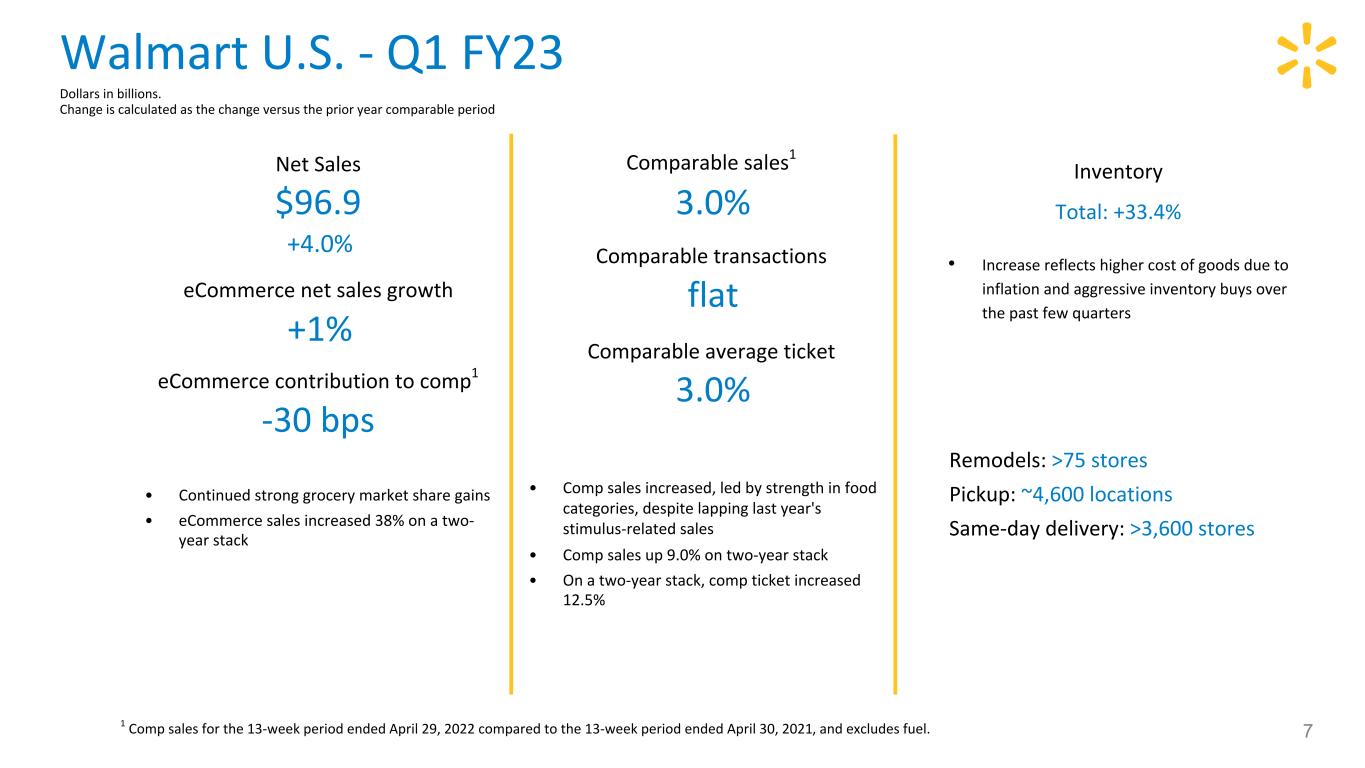
7 Net Sales $96.9 +4.0% eCommerce net sales growth +1% eCommerce contribution to comp1 -30 bps Inventory Total: +33.4% Comparable sales1 3.0% Comparable transactions flat Comparable average ticket 3.0% • Continued strong grocery market share gains • eCommerce sales increased 38% on a two- year stack • Comp sales increased, led by strength in food categories, despite lapping last year's stimulus-related sales • Comp sales up 9.0% on two-year stack • On a two-year stack, comp ticket increased 12.5% Remodels: >75 stores Pickup: ~4,600 locations Same-day delivery: >3,600 stores • Increase reflects higher cost of goods due to inflation and aggressive inventory buys over the past few quarters 1 Comp sales for the 13-week period ended April 29, 2022 compared to the 13-week period ended April 30, 2021, and excludes fuel. Walmart U.S. - Q1 FY23 Dollars in billions. Change is calculated as the change versus the prior year comparable period
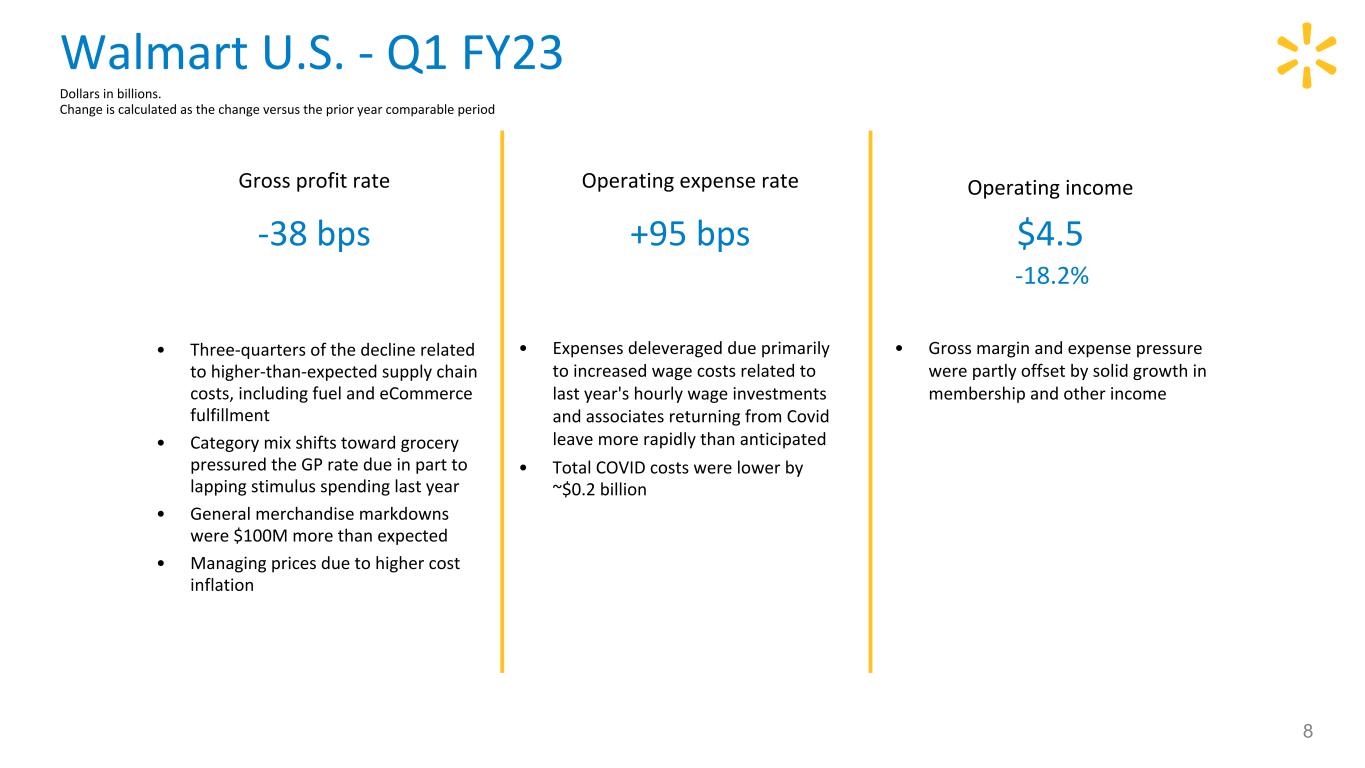
8 Gross profit rate -38 bps Operating income $4.5 -18.2% Operating expense rate +95 bps • Three-quarters of the decline related to higher-than-expected supply chain costs, including fuel and eCommerce fulfillment • Category mix shifts toward grocery pressured the GP rate due in part to lapping stimulus spending last year • General merchandise markdowns were $100M more than expected • Managing prices due to higher cost inflation • Expenses deleveraged due primarily to increased wage costs related to last year's hourly wage investments and associates returning from Covid leave more rapidly than anticipated • Total COVID costs were lower by ~$0.2 billion Adj. operating income1 $4.5 -18.2% Walmart U.S. - Q1 FY23 Dollars in billions. Change is calculated as the change versus the prior year comparable period 1 See press release located at www.stock.walmart.com and reconciliations at the end of presentation regarding non-GAAP financial measures. • Gross margin and expense pressure were partly offset by solid growth in membership and other income
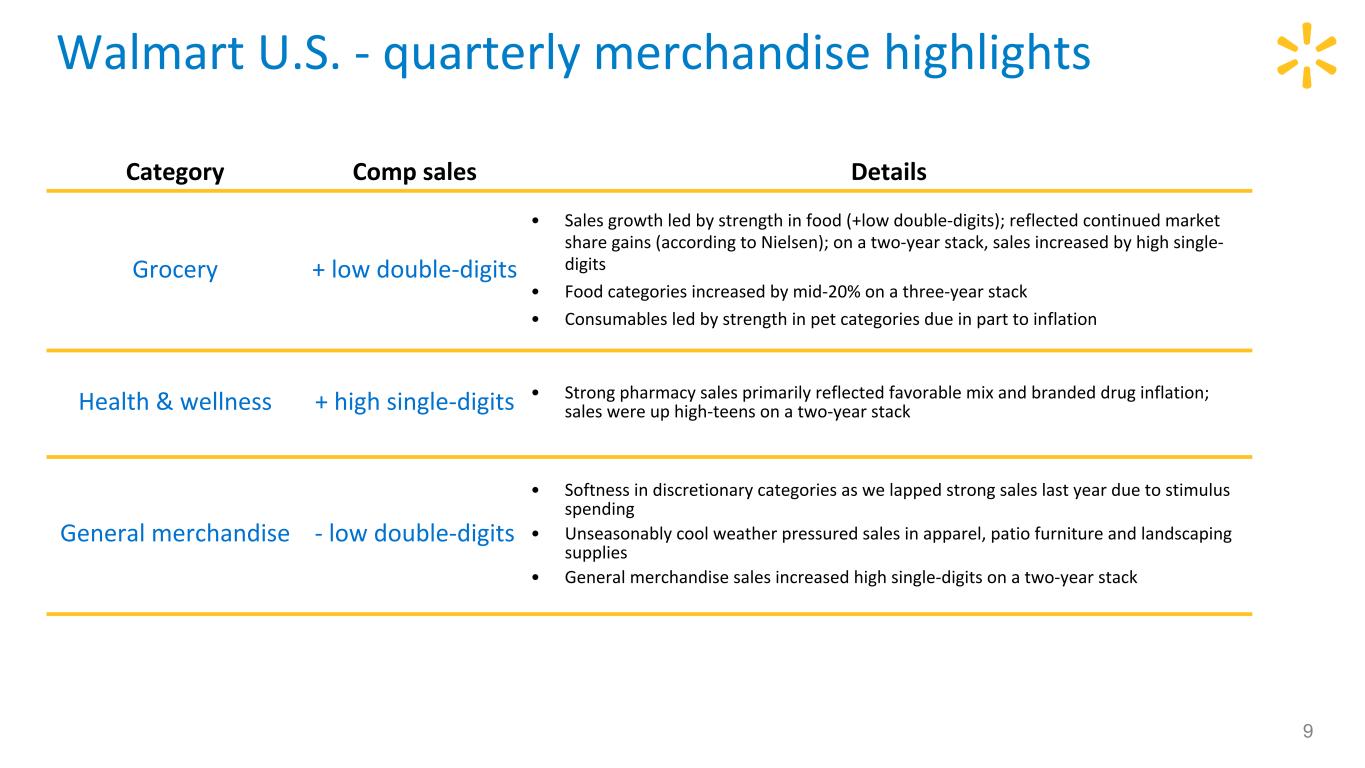
Walmart U.S. - quarterly merchandise highlights 9 Category Comp sales Details Grocery + low double-digits • Sales growth led by strength in food (+low double-digits); reflected continued market share gains (according to Nielsen); on a two-year stack, sales increased by high single- digits • Food categories increased by mid-20% on a three-year stack • Consumables led by strength in pet categories due in part to inflation Health & wellness + high single-digits • Strong pharmacy sales primarily reflected favorable mix and branded drug inflation; sales were up high-teens on a two-year stack General merchandise - low double-digits • Softness in discretionary categories as we lapped strong sales last year due to stimulus spending • Unseasonably cool weather pressured sales in apparel, patio furniture and landscaping supplies • General merchandise sales increased high single-digits on a two-year stack
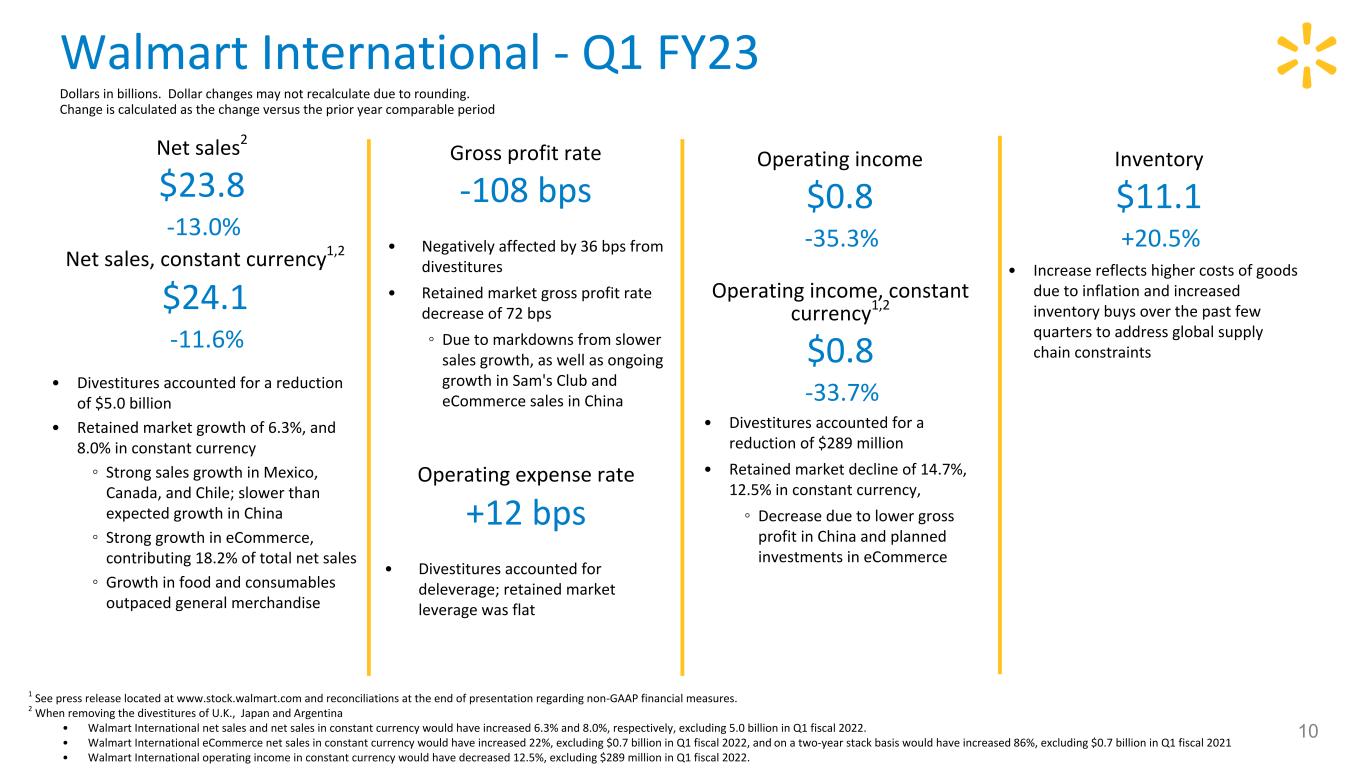
• Divestitures accounted for deleverage; retained market leverage was flat • Increase reflects higher costs of goods due to inflation and increased inventory buys over the past few quarters to address global supply chain constraints 10 1 See press release located at www.stock.walmart.com and reconciliations at the end of presentation regarding non-GAAP financial measures. 2 When removing the divestitures of U.K., Japan and Argentina • Walmart International net sales and net sales in constant currency would have increased 6.3% and 8.0%, respectively, excluding 5.0 billion in Q1 fiscal 2022. • Walmart International eCommerce net sales in constant currency would have increased 22%, excluding $0.7 billion in Q1 fiscal 2022, and on a two-year stack basis would have increased 86%, excluding $0.7 billion in Q1 fiscal 2021 • Walmart International operating income in constant currency would have decreased 12.5%, excluding $289 million in Q1 fiscal 2022. Inventory $11.1 +20.5% Gross profit rate -108 bps Operating income $0.8 -35.3% Net sales, constant currency1,2 $24.1 -11.6% Operating expense rate +12 bps Operating income, constant currency1,2 $0.8 -33.7% • Negatively affected by 36 bps from divestitures • Retained market gross profit rate decrease of 72 bps ◦ Due to markdowns from slower sales growth, as well as ongoing growth in Sam's Club and eCommerce sales in China Net sales2 $23.8 -13.0% Walmart International - Q1 FY23 Dollars in billions. Dollar changes may not recalculate due to rounding. Change is calculated as the change versus the prior year comparable period • Divestitures accounted for a reduction of $289 million • Retained market decline of 14.7%, 12.5% in constant currency, ◦ Decrease due to lower gross profit in China and planned investments in eCommerce Adj. operating income1 $0.9 -26.3% • Divestitures accounted for a reduction of $5.0 billion • Retained market growth of 6.3%, and 8.0% in constant currency ◦ Strong sales growth in Mexico, Canada, and Chile; slower than expected growth in China ◦ Strong growth in eCommerce, contributing 18.2% of total net sales ◦ Growth in food and consumables outpaced general merchandise Adj. operating income, constant currency1,2 $0.9 -24.5% • Retained market growth of 2.7% • Retained market growth of 0.8%
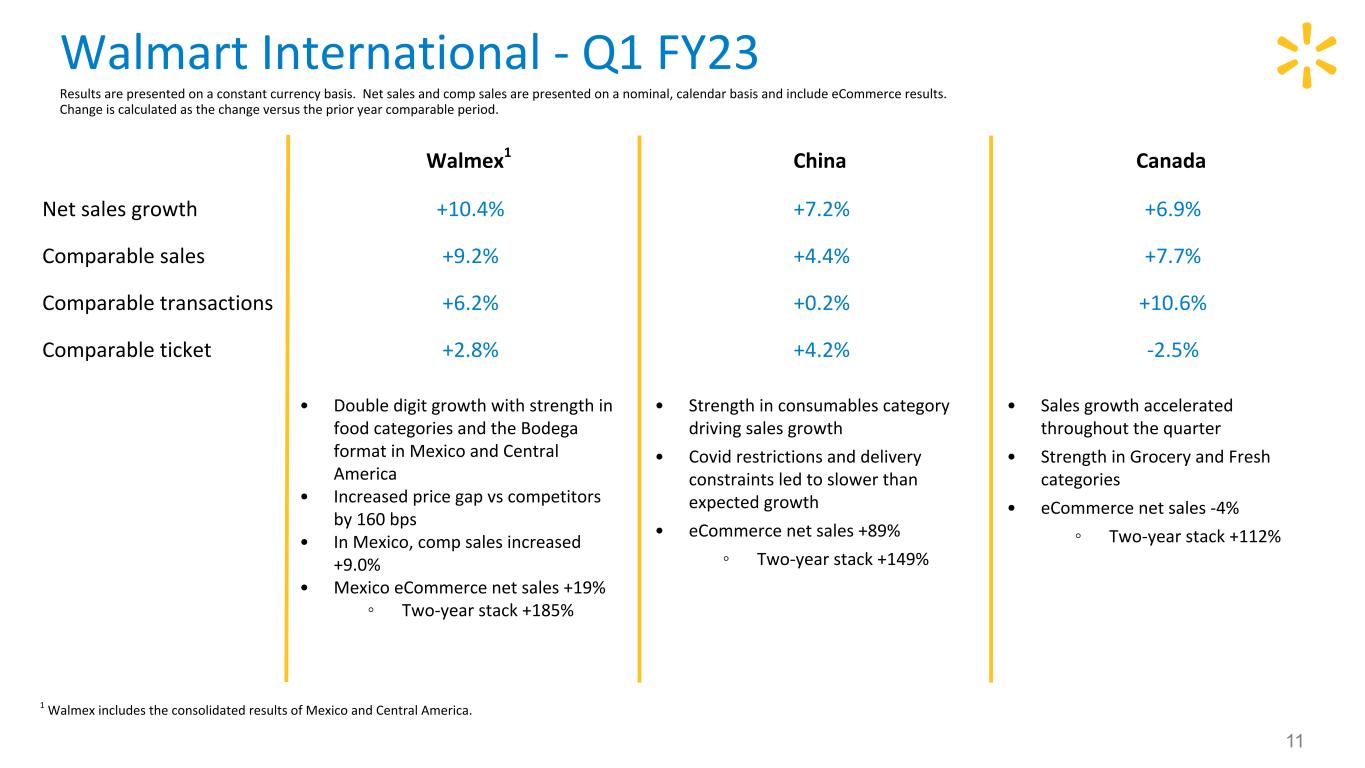
• Sales growth accelerated throughout the quarter • Strength in Grocery and Fresh categories • eCommerce net sales -4% ◦ Two-year stack +112% 1 Walmex includes the consolidated results of Mexico and Central America. 11 Walmex1 China Canada Net sales growth +10.4% +7.2% +6.9% Comparable sales +9.2% +4.4% +7.7% Comparable transactions +6.2% +0.2% +10.6% Comparable ticket +2.8% +4.2% -2.5% • Double digit growth with strength in food categories and the Bodega format in Mexico and Central America • Increased price gap vs competitors by 160 bps • In Mexico, comp sales increased +9.0% • Mexico eCommerce net sales +19% ◦ Two-year stack +185% • Strength in consumables category driving sales growth • Covid restrictions and delivery constraints led to slower than expected growth • eCommerce net sales +89% ◦ Two-year stack +149% Walmart International - Q1 FY23 Results are presented on a constant currency basis. Net sales and comp sales are presented on a nominal, calendar basis and include eCommerce results. Change is calculated as the change versus the prior year comparable period.

• Higher sales driving leverage and lapping LY write down on land • Higher penetration of Sam’s Club lower operating expense • Continued elevated import and logistic costs 1 Walmex includes the consolidated results of Mexico and Central America. 12 Walmex1 China Canada Gross profit rate Slight Increase Decrease Decrease x • Better sales from Health & Beauty and Apparel categories and continued contribution of Walmart Connect • Due to markdowns from slower sales growth, as well as higher mix of Sam's Club and eCommerce sales Operating expense rate Slight Increase Decrease Decrease Operating income $ Increase Decrease Increase Walmart International - Q1 FY23 Results are presented on a constant currency basis. Change is calculated as the change versus the prior year comparable period • Planned investments behind strategic priorities, including associates, IT, and e-Commerce
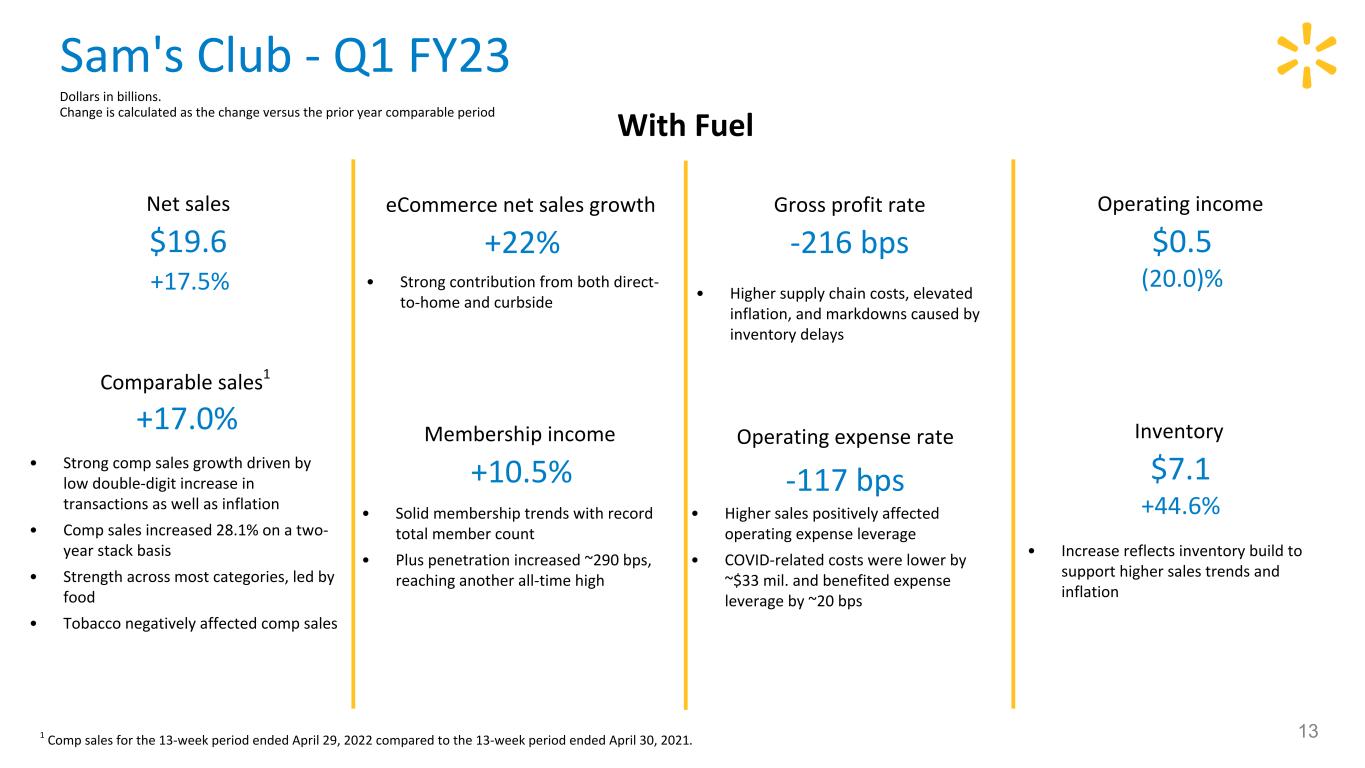
13 +10.2% Comparable sales +10.0% Comparable transactions +0.2% Average comparable ticket ~150 bps eCommerce contribution $16,532 +11% Net sales +10.5% Membership income -219 bps Gross profit rate -63 bps Operating expense rate $335 -36.8% Operating income With Fuel Without Fuel Comparable sales1 +17.0% Net sales $19.6 +17.5% eCommerce net sales growth +22% Comparable sales +17% Membership income +10.5% Gross profit rate -216 bps Operating expense rate -117 bps Inventory $7.1 +44.6% Operating income $0.5 (20.0)% • Solid membership trends with record total member count • Plus penetration increased ~290 bps, reaching another all-time high • Higher sales positively affected operating expense leverage • COVID-related costs were lower by ~$33 mil. and benefited expense leverage by ~20 bps • Higher supply chain costs, elevated inflation, and markdowns caused by inventory delays • Strong contribution from both direct- to-home and curbside • Strong comp sales growth driven by low double-digit increase in transactions as well as inflation • Comp sales increased 28.1% on a two- year stack basis • Strength across most categories, led by food • Tobacco negatively affected comp sales 1 Comp sales for the 13-week period ended April 29, 2022 compared to the 13-week period ended April 30, 2021. • Increase reflects inventory build to support higher sales trends and inflation Sam's Club - Q1 FY23 Dollars in billions. Change is calculated as the change versus the prior year comparable period
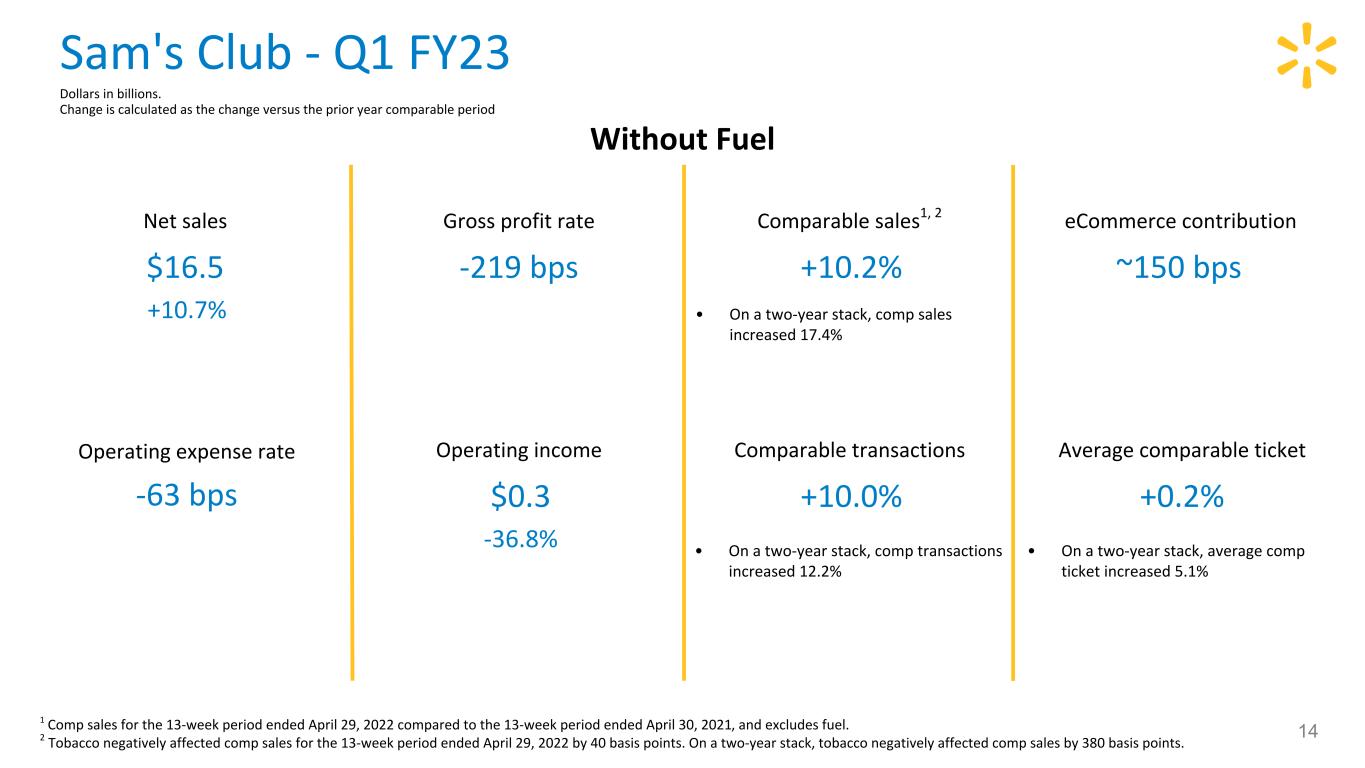
14 $19,621 +17.5% Net Sales +33% eCommerce net sales growth +17% Comparable sales -216 bps Gross profit rate -117 bps Operating expense rate $460 (20)% Operating income Without Fuel Net sales $16.5 +10.7% Operating expense rate -63 bps Gross profit rate -219 bps Operating income $0.3 -36.8% Comparable transactions +10.0% Comparable sales1, 2 +10.2% eCommerce contribution ~150 bps Average comparable ticket +0.2% 1 Comp sales for the 13-week period ended April 29, 2022 compared to the 13-week period ended April 30, 2021, and excludes fuel. 2 Tobacco negatively affected comp sales for the 13-week period ended April 29, 2022 by 40 basis points. On a two-year stack, tobacco negatively affected comp sales by 380 basis points. Sam's Club - Q1 FY23 Dollars in billions. Change is calculated as the change versus the prior year comparable period • On a two-year stack, average comp ticket increased 5.1% • On a two-year stack, comp sales increased 17.4% • On a two-year stack, comp transactions increased 12.2%
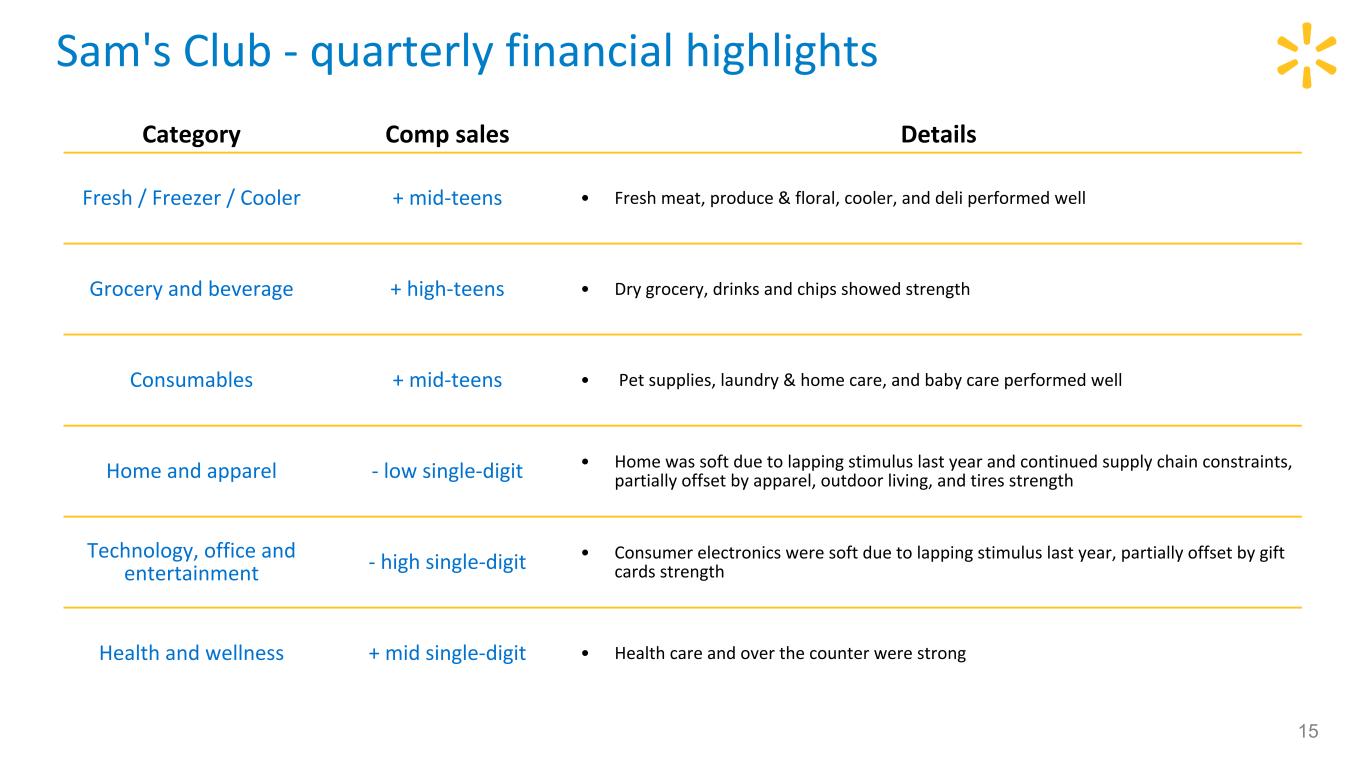
15 Category Comp sales Details Fresh / Freezer / Cooler + mid-teens • Fresh meat, produce & floral, cooler, and deli performed well Grocery and beverage + high-teens • Dry grocery, drinks and chips showed strength Consumables + mid-teens • Pet supplies, laundry & home care, and baby care performed well Home and apparel - low single-digit • Home was soft due to lapping stimulus last year and continued supply chain constraints, partially offset by apparel, outdoor living, and tires strength Technology, office and entertainment - high single-digit • Consumer electronics were soft due to lapping stimulus last year, partially offset by gift cards strength Health and wellness + mid single-digit • Health care and over the counter were strong Sam's Club - quarterly financial highlights
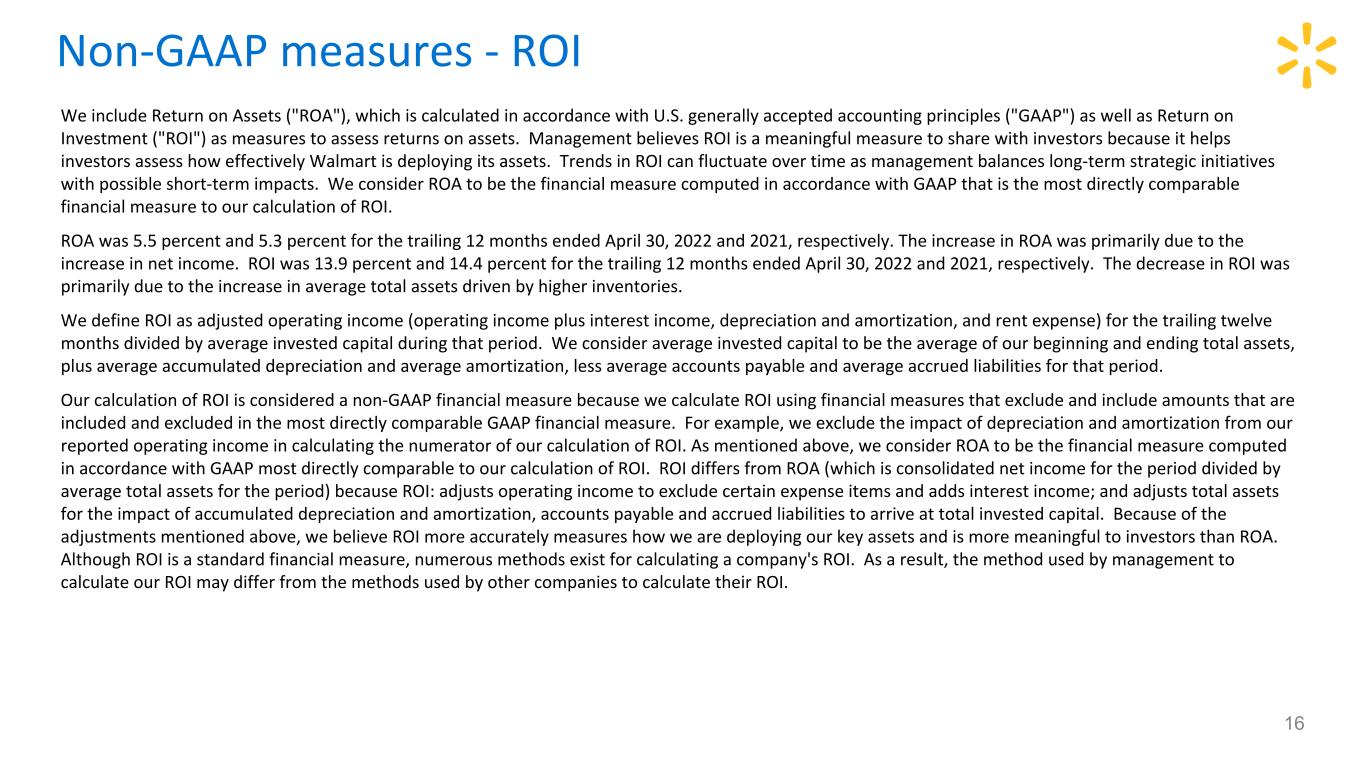
We include Return on Assets ("ROA"), which is calculated in accordance with U.S. generally accepted accounting principles ("GAAP") as well as Return on Investment ("ROI") as measures to assess returns on assets. Management believes ROI is a meaningful measure to share with investors because it helps investors assess how effectively Walmart is deploying its assets. Trends in ROI can fluctuate over time as management balances long-term strategic initiatives with possible short-term impacts. We consider ROA to be the financial measure computed in accordance with GAAP that is the most directly comparable financial measure to our calculation of ROI. ROA was 5.5 percent and 5.3 percent for the trailing 12 months ended April 30, 2022 and 2021, respectively. The increase in ROA was primarily due to the increase in net income. ROI was 13.9 percent and 14.4 percent for the trailing 12 months ended April 30, 2022 and 2021, respectively. The decrease in ROI was primarily due to the increase in average total assets driven by higher inventories. We define ROI as adjusted operating income (operating income plus interest income, depreciation and amortization, and rent expense) for the trailing twelve months divided by average invested capital during that period. We consider average invested capital to be the average of our beginning and ending total assets, plus average accumulated depreciation and average amortization, less average accounts payable and average accrued liabilities for that period. Our calculation of ROI is considered a non-GAAP financial measure because we calculate ROI using financial measures that exclude and include amounts that are included and excluded in the most directly comparable GAAP financial measure. For example, we exclude the impact of depreciation and amortization from our reported operating income in calculating the numerator of our calculation of ROI. As mentioned above, we consider ROA to be the financial measure computed in accordance with GAAP most directly comparable to our calculation of ROI. ROI differs from ROA (which is consolidated net income for the period divided by average total assets for the period) because ROI: adjusts operating income to exclude certain expense items and adds interest income; and adjusts total assets for the impact of accumulated depreciation and amortization, accounts payable and accrued liabilities to arrive at total invested capital. Because of the adjustments mentioned above, we believe ROI more accurately measures how we are deploying our key assets and is more meaningful to investors than ROA. Although ROI is a standard financial measure, numerous methods exist for calculating a company's ROI. As a result, the method used by management to calculate our ROI may differ from the methods used by other companies to calculate their ROI. 16 Non-GAAP measures - ROI
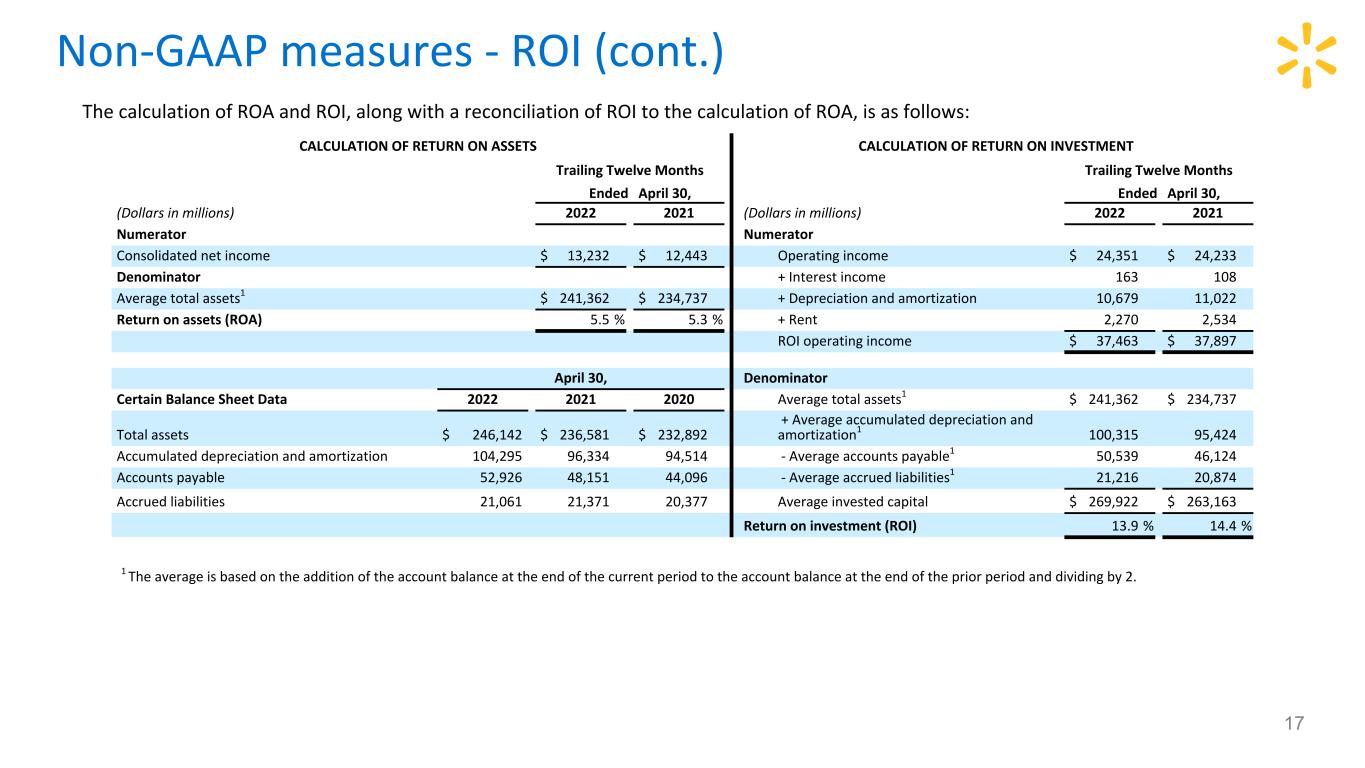
The calculation of ROA and ROI, along with a reconciliation of ROI to the calculation of ROA, is as follows: 17 3 Upon adoption of ASU 2016-02, Leases, a factor of eight times rent is no longer included in the calculation of ROI on a prospective basis as operating lease assets are now recorded on the Consolidated Balance Sheet. 1 The average is based on the addition of the account balance at the end of the current period to the account balance at the end of the prior period and dividing by 2. 2 The average is based on the addition of 'total assets without leased assets, net' at the end of the current period to 'total assets without leased assets, net' at the end of the prior period and dividing by 2, plus 'leased assets, net' at the end of the current period. 3 The average is based on the addition of 'accumulated depreciation and amortization, without leased assets' at the end of the current period to 'accumulated depreciation and amortization, without leased assets' at the end of the prior period and dividing by 2, plus 'accumulated amortization on leased assets' at the end of the current period. NP = not provided CALCULATION OF RETURN ON ASSETS CALCULATION OF RETURN ON INVESTMENT Trailing Twelve Months Trailing Twelve Months Ended April 30, Ended April 30, (Dollars in millions) 2022 2021 (Dollars in millions) 2022 2021 Numerator Numerator Consolidated net income $ 13,232 $ 12,443 Operating income $ 24,351 $ 24,233 Denominator + Interest income 163 108 Average total assets1 $ 241,362 $ 234,737 + Depreciation and amortization 10,679 11,022 Return on assets (ROA) 5.5 % 5.3 % + Rent 2,270 2,534 ROI operating income $ 37,463 $ 37,897 April 30, Denominator Certain Balance Sheet Data 2022 2021 2020 Average total assets1 $ 241,362 $ 234,737 Total assets $ 246,142 $ 236,581 $ 232,892 '+ Average accumulated depreciation and amortization1 100,315 95,424 Accumulated depreciation and amortization 104,295 96,334 94,514 '- Average accounts payable1 50,539 46,124 Accounts payable 52,926 48,151 44,096 '- Average accrued liabilities1 21,216 20,874 Accrued liabilities 21,061 21,371 20,377 Average invested capital $ 269,922 $ 263,163 Return on investment (ROI) 13.9 % 14.4 % 1 The average is based on the addition of the account balance at the end of the current period to the account balance at the end of the prior period and dividing by 2. Non-GAAP measures - ROI (cont.)
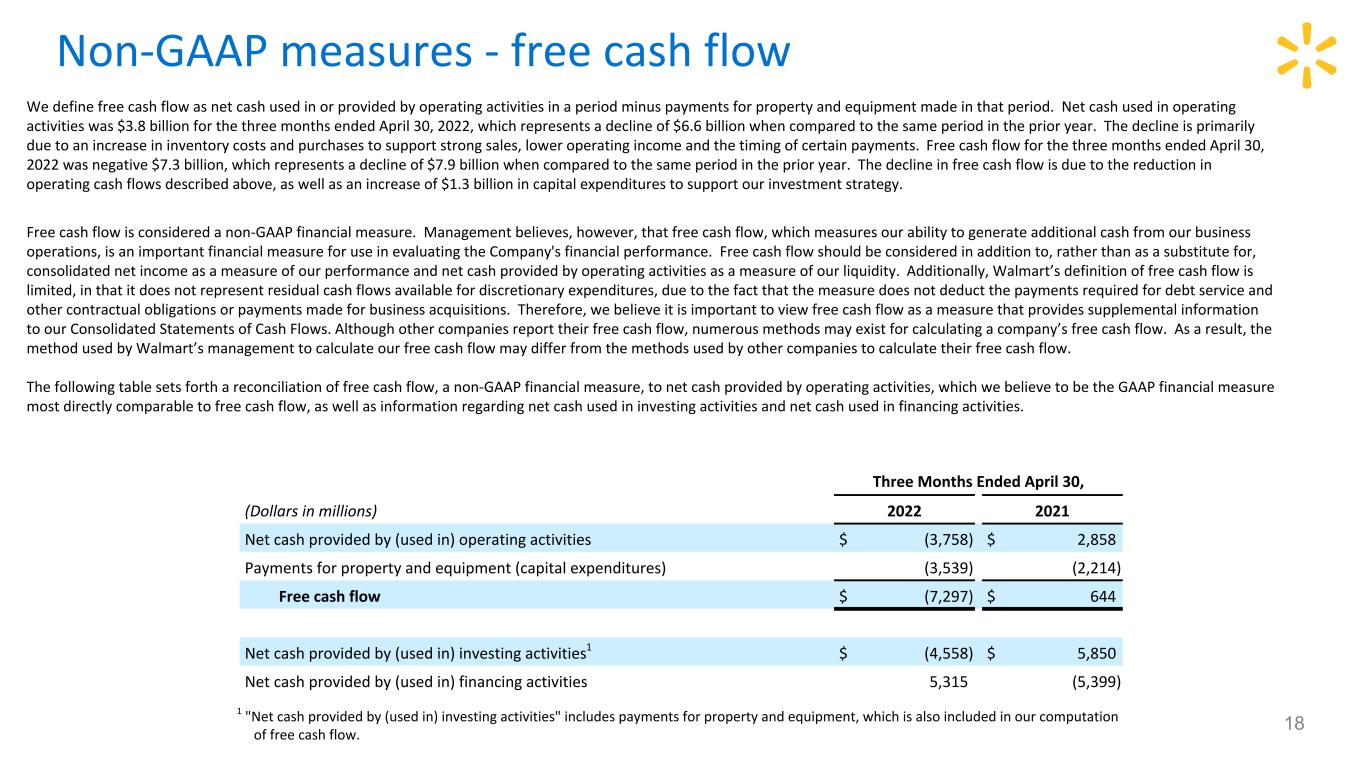
1 "Net cash provided by (used in) investing activities" includes payments for property and equipment, which is also included in our computation of free cash flow. 18 We define free cash flow as net cash used in or provided by operating activities in a period minus payments for property and equipment made in that period. Net cash used in operating activities was $3.8 billion for the three months ended April 30, 2022, which represents a decline of $6.6 billion when compared to the same period in the prior year. The decline is primarily due to an increase in inventory costs and purchases to support strong sales, lower operating income and the timing of certain payments. Free cash flow for the three months ended April 30, 2022 was negative $7.3 billion, which represents a decline of $7.9 billion when compared to the same period in the prior year. The decline in free cash flow is due to the reduction in operating cash flows described above, as well as an increase of $1.3 billion in capital expenditures to support our investment strategy. Free cash flow is considered a non-GAAP financial measure. Management believes, however, that free cash flow, which measures our ability to generate additional cash from our business operations, is an important financial measure for use in evaluating the Company's financial performance. Free cash flow should be considered in addition to, rather than as a substitute for, consolidated net income as a measure of our performance and net cash provided by operating activities as a measure of our liquidity. Additionally, Walmart’s definition of free cash flow is limited, in that it does not represent residual cash flows available for discretionary expenditures, due to the fact that the measure does not deduct the payments required for debt service and other contractual obligations or payments made for business acquisitions. Therefore, we believe it is important to view free cash flow as a measure that provides supplemental information to our Consolidated Statements of Cash Flows. Although other companies report their free cash flow, numerous methods may exist for calculating a company’s free cash flow. As a result, the method used by Walmart’s management to calculate our free cash flow may differ from the methods used by other companies to calculate their free cash flow. The following table sets forth a reconciliation of free cash flow, a non-GAAP financial measure, to net cash provided by operating activities, which we believe to be the GAAP financial measure most directly comparable to free cash flow, as well as information regarding net cash used in investing activities and net cash used in financing activities. Three Months Ended April 30, (Dollars in millions) 2022 2021 Net cash provided by (used in) operating activities $ (3,758) $ 2,858 Payments for property and equipment (capital expenditures) (3,539) (2,214) Free cash flow $ (7,297) $ 644 Net cash provided by (used in) investing activities1 $ (4,558) $ 5,850 Net cash provided by (used in) financing activities 5,315 (5,399) Non-GAAP measures - free cash flow

1 Change versus prior year comparable period. 2 Walmart International eCommerce net sales were $4.3 billion for the three months ended April 30, 2022, which was negatively impacted by $54 million of currency exchange rate fluctuations. 3 Walmart International eCommerce net sales were flat on a reported basis and increased 1% in constant currency for the three months ended April 30, 2022. 19 In discussing our operating results, the term currency exchange rates refers to the currency exchange rates we use to convert the operating results for countries where the functional currency is not the U.S. dollar into U.S. dollars. We calculate the effect of changes in currency exchange rates as the difference between current period activity translated using the current period's currency exchange rates and the comparable prior year period's currency exchange rates. Additionally, no currency exchange rate fluctuations are calculated for non- USD acquisitions until owned for 12 months. Throughout our discussion, we refer to the results of this calculation as the impact of currency exchange rate fluctuations. When we refer to constant currency operating results, this means operating results without the impact of the currency exchange rate fluctuations. The disclosure of constant currency amounts or results permits investors to better understand Walmart’s underlying performance without the effects of currency exchange rate fluctuations. The table below reflects the calculation of constant currency for total revenues, net sales and operating income for the three months ended April 30, 2022. Three Months Ended April 30, 2022 2022 Percent Change1 2022 Percent Change1 (Dollars in millions) Walmart International Consolidated Total revenues: As reported $ 24,101 -12.9 % $ 141,569 2.4 % Currency exchange rate fluctuations 377 N/A 377 N/A Constant currency total revenues $ 24,478 -11.5 % $ 141,946 2.6 % Net sales2,3: As reported $ 23,763 -13.0 % $ 140,288 2.3 % Currency exchange rate fluctuations 376 N/A 376 N/A Constant currency net sales $ 24,139 -11.6 % $ 140,664 2.6 % Operating income: As reported $ 772 -35.3 % $ 5,318 -23.0 % Currency exchange rate fluctuations 20 N/A 20 N/A Constant currency operating income $ 792 -33.7 % $ 5,338 -22.7 % Non-GAAP measures - constant currency 1 Change versus prior year comparable period. 2 Consolidated eCommerce net sales were $21.9 billion and $13.3 billion for the three months ended January 31, 2022 and 2020, respectively. 3 Walmart International eCommerce net sales were $5.8 billion and $18.5 billion for the three months and fiscal year ended January 31, 2022, and were negatively impacted by $30 million and positively impacted by $471 million of currency exchange rate fluctuations, respectively. 4 Walmart International eCommerce net sales decreased 5% on a reported basis and 5% in constant currency and increased 11% on a reported basis and 8.7% in constant currency for the three and fiscal year ended January 31, 2022, respectively.
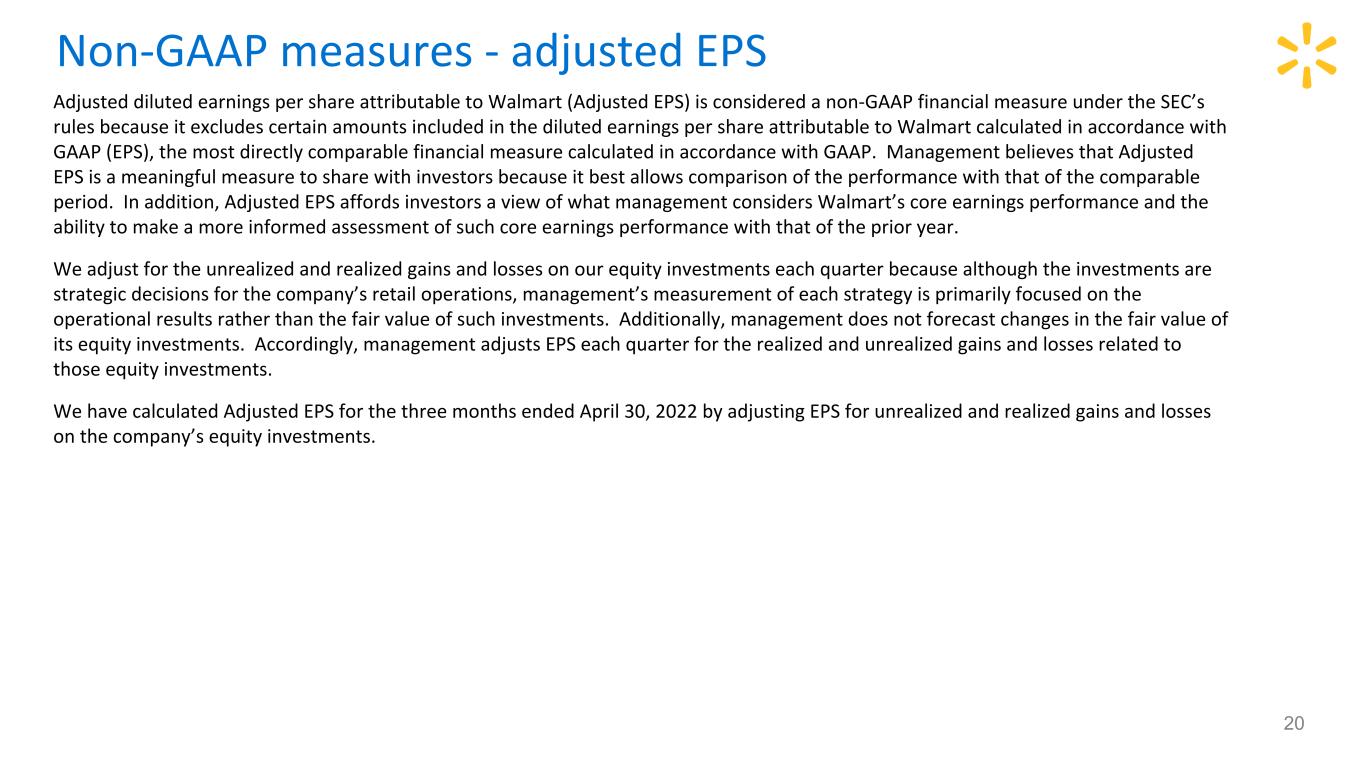
20 Adjusted diluted earnings per share attributable to Walmart (Adjusted EPS) is considered a non-GAAP financial measure under the SEC’s rules because it excludes certain amounts included in the diluted earnings per share attributable to Walmart calculated in accordance with GAAP (EPS), the most directly comparable financial measure calculated in accordance with GAAP. Management believes that Adjusted EPS is a meaningful measure to share with investors because it best allows comparison of the performance with that of the comparable period. In addition, Adjusted EPS affords investors a view of what management considers Walmart’s core earnings performance and the ability to make a more informed assessment of such core earnings performance with that of the prior year. We adjust for the unrealized and realized gains and losses on our equity investments each quarter because although the investments are strategic decisions for the company’s retail operations, management’s measurement of each strategy is primarily focused on the operational results rather than the fair value of such investments. Additionally, management does not forecast changes in the fair value of its equity investments. Accordingly, management adjusts EPS each quarter for the realized and unrealized gains and losses related to those equity investments. We have calculated Adjusted EPS for the three months ended April 30, 2022 by adjusting EPS for unrealized and realized gains and losses on the company’s equity investments. Non-GAAP measures - adjusted EPS
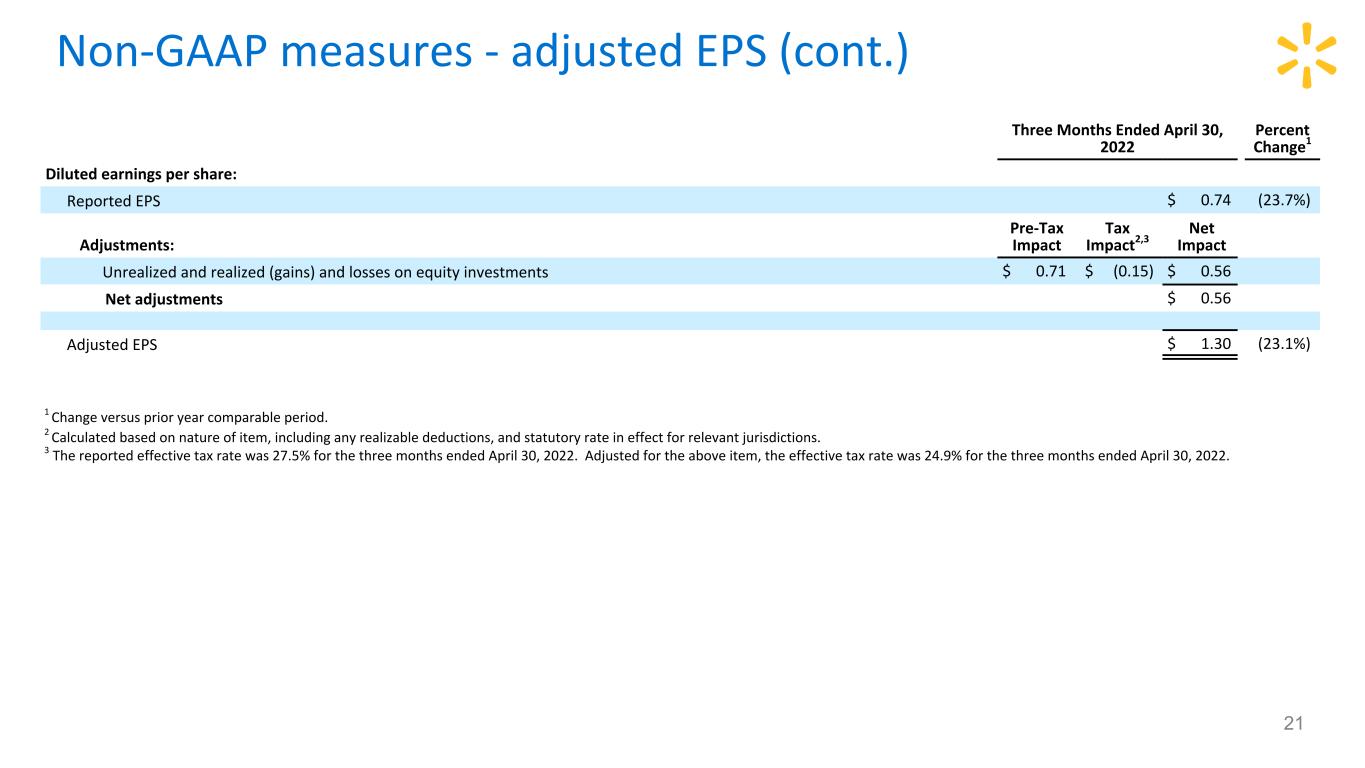
21 1 Change versus prior year comparable period. 2 Calculated based on nature of item, including any realizable deductions, and statutory rate in effect for relevant jurisdictions. 3 The reported effective tax rate was 27.5% for the three months ended April 30, 2022. Adjusted for the above item, the effective tax rate was 24.9% for the three months ended April 30, 2022. Three Months Ended April 30, 2022 Percent Change1 Diluted earnings per share: Reported EPS $ 0.74 (23.7%) Adjustments: Pre-Tax Impact Tax Impact2,3 Net Impact Unrealized and realized (gains) and losses on equity investments $ 0.71 $ (0.15) $ 0.56 Net adjustments $ 0.56 Adjusted EPS $ 1.30 (23.1%) Non-GAAP measures - adjusted EPS (cont.)
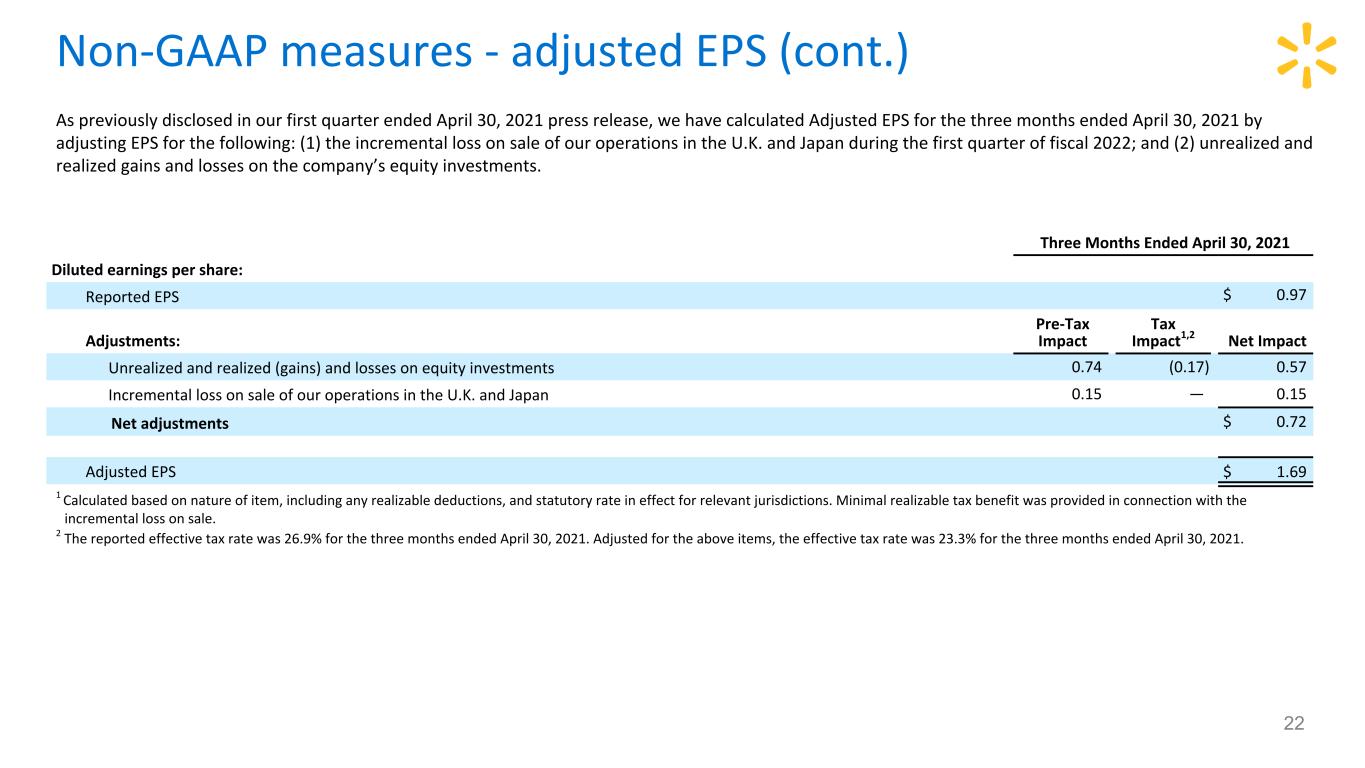
22 As previously disclosed in our first quarter ended April 30, 2021 press release, we have calculated Adjusted EPS for the three months ended April 30, 2021 by adjusting EPS for the following: (1) the incremental loss on sale of our operations in the U.K. and Japan during the first quarter of fiscal 2022; and (2) unrealized and realized gains and losses on the company’s equity investments. Three Months Ended April 30, 2021 Diluted earnings per share: Reported EPS $ 0.97 Adjustments: Pre-Tax Impact Tax Impact1,2 Net Impact Unrealized and realized (gains) and losses on equity investments 0.74 (0.17) 0.57 Incremental loss on sale of our operations in the U.K. and Japan 0.15 — 0.15 Net adjustments $ 0.72 Adjusted EPS $ 1.69 Non-GAAP measures - adjusted EPS (cont.) 1 Calculated based on nature of item, including any realizable deductions, and statutory rate in effect for relevant jurisdictions. Minimal realizable tax benefit was provided in connection with the incremental loss on sale. 2 The reported effective tax rate was 26.9% for the three months ended April 30, 2021. Adjusted for the above items, the effective tax rate was 23.3% for the three months ended April 30, 2021.
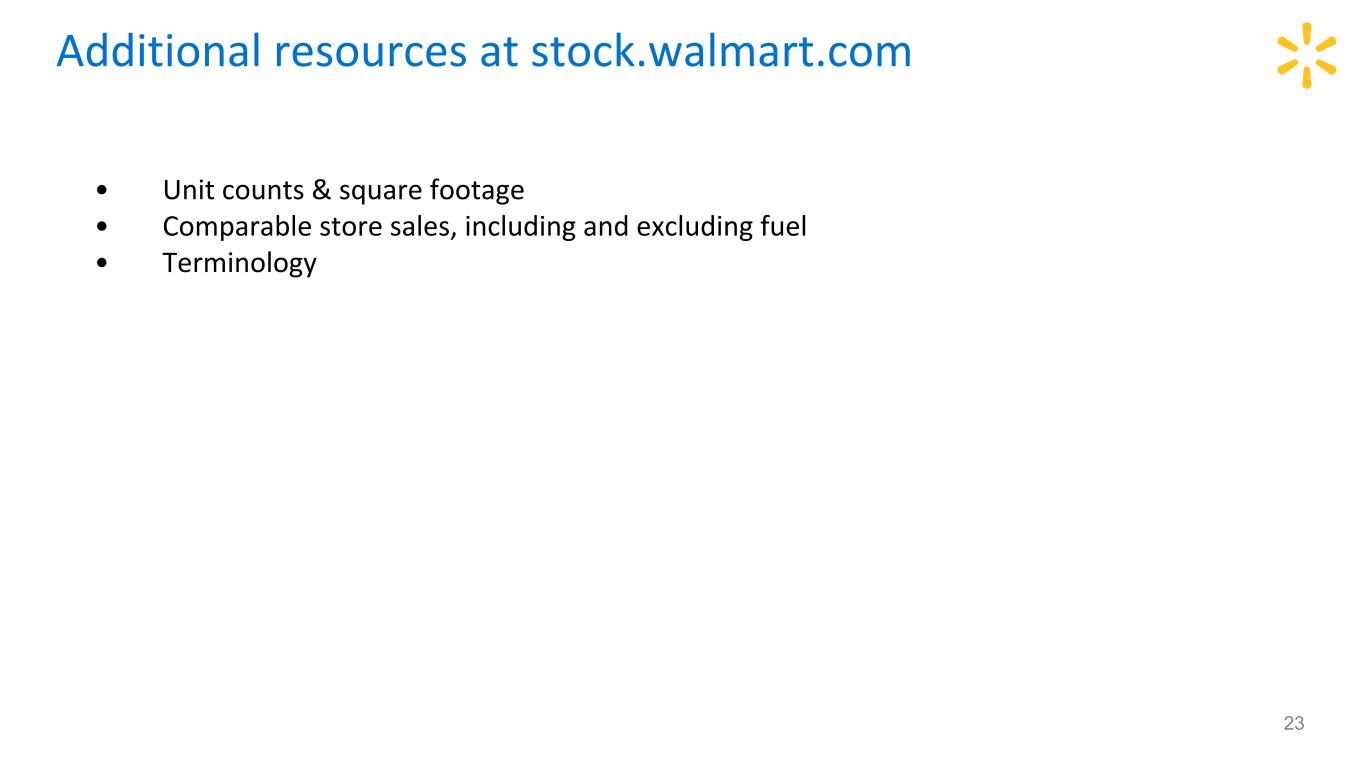
• Unit counts & square footage • Comparable store sales, including and excluding fuel • Terminology 23 Additional resources at stock.walmart.com






















